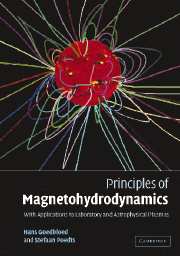Book contents
- Frontmatter
- Contents
- Preface
- Part I Plasma physics preliminaries
- Part II Basic magnetohydrodynamics
- 4 The MHD model
- 5 Waves and characteristics
- 6 Spectral theory
- 7 Waves and instabilities of inhomogeneous plasmas
- 8 Magnetic structures and dynamics
- 9 Cylindrical plasmas
- 10 Initial value problem and wave damping
- 11 Resonant absorption and wave heating
- Appendices
- References
- Index
6 - Spectral theory
Published online by Cambridge University Press: 22 February 2010
- Frontmatter
- Contents
- Preface
- Part I Plasma physics preliminaries
- Part II Basic magnetohydrodynamics
- 4 The MHD model
- 5 Waves and characteristics
- 6 Spectral theory
- 7 Waves and instabilities of inhomogeneous plasmas
- 8 Magnetic structures and dynamics
- 9 Cylindrical plasmas
- 10 Initial value problem and wave damping
- 11 Resonant absorption and wave heating
- Appendices
- References
- Index
Summary
Stability: intuitive approach
Two viewpoints
How does one know whether a dynamical system is stable or not? Consider the well-known example of a ball at rest at the bottom of a trough or on the top of a hill (Fig. 6.1). There is a position (indicated by the full circle) where the potential energy W due to gravity has an extremum W0. Displacing the ball slightly to a neighbouring position (at the open circle) results in either a higher or a lower potential energy W1. This corresponds to a stable system in the first case (W1 > W0) and an unstable system in the second case (W1 < W0).
Already at this stage some important observations can be made, viz.:
(a) We have tacitly assumed that the constraining surface is curved, i.e. either convex or concave, so that there is a position of rest, which is called the equilibrium position. In this case, one may rescale the potential energy such that the equilibrium state corresponds to W0 = 0, and W1 becomes the potential energy of the displacement, which is called the perturbation.
(b) If the constraining surface is flat and inclined, the system is not in equilibrium and the ball simply rolls along the plane. This lack of equilibrium, when W has no extremum, should be well distinguished from neutral or marginal stability, when W1 = W0. The latter situation occurs when the surface is horizontal, so that the value W = 0 may be assigned to both W0 and W1.
- Type
- Chapter
- Information
- Principles of MagnetohydrodynamicsWith Applications to Laboratory and Astrophysical Plasmas, pp. 230 - 299Publisher: Cambridge University PressPrint publication year: 2004



